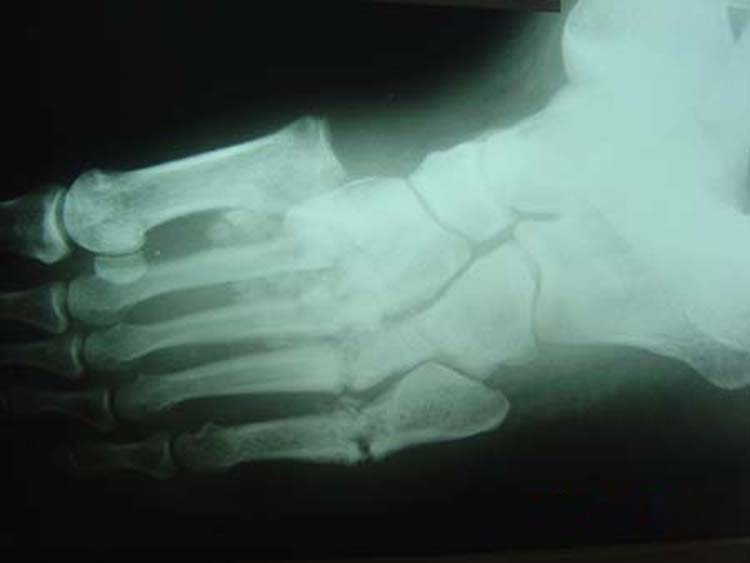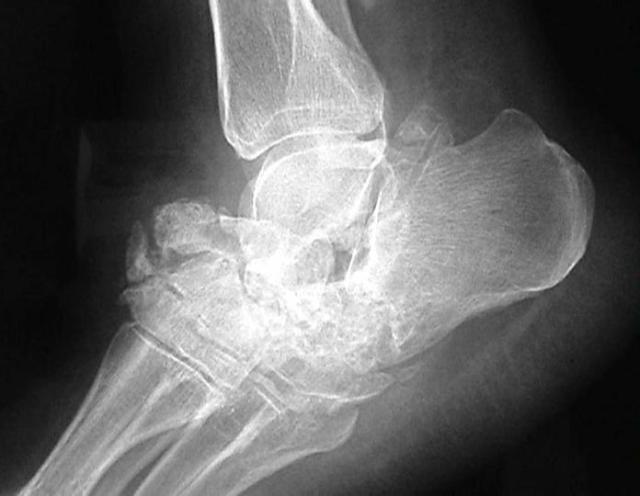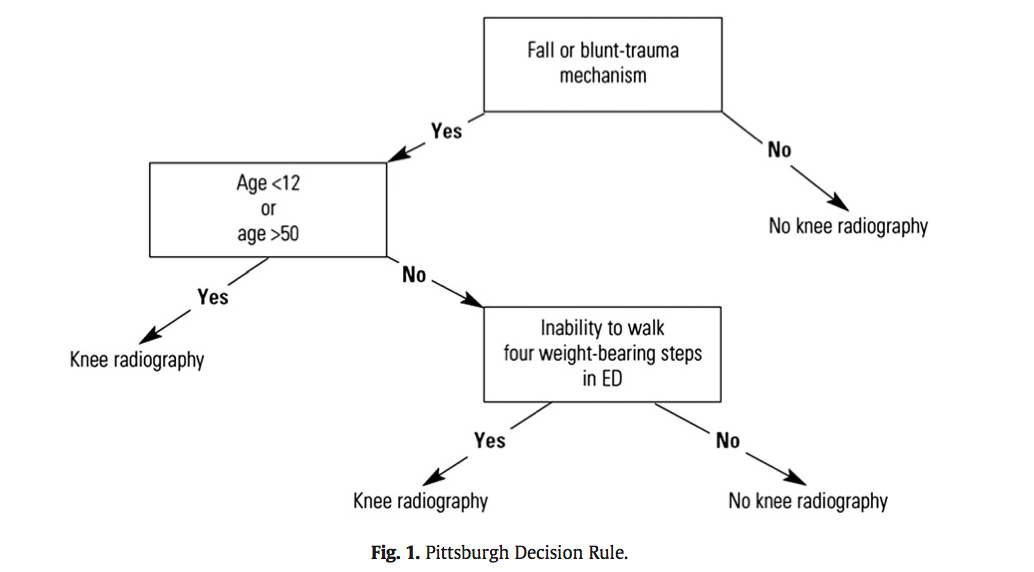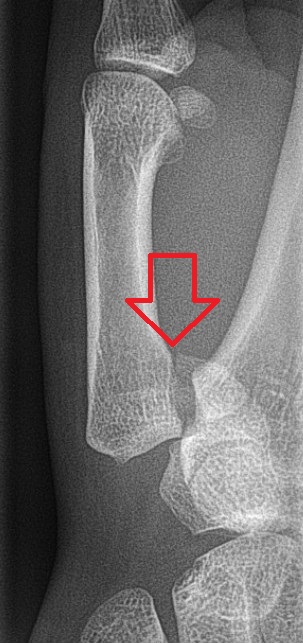Category: Orthopedics
Keywords: Posterior, Dislocation, Shoulder (PubMed Search)
Posted: 11/30/2013 by Michael Bond, MD
(Updated: 12/5/2025)
Click here to contact Michael Bond, MD
Posterior Shoulder Dislocations

(A posterior shoulder dislocation will show the humeral head displayed superiorly in the image away from the clavicle which is the inferior most bone)
Some things to look for on the AP view that will suggest a posterior shoulder dislocation:
Life in the Fast Lane as a great discussion of posterior shoulder dislocations at http://lifeinthefastlane.com/posterior-shoulder-dislocation/
Best way to make the diagnosis --- suspect it and get an axillary view.
Category: Orthopedics
Keywords: Compartment Syndrome (PubMed Search)
Posted: 11/16/2013 by Michael Bond, MD
(Updated: 12/5/2025)
Click here to contact Michael Bond, MD
Compartment Syndrome
Compartment syndrome is classically described as having the 6 Ps:
The diagnosis of compartment syndrome can be difficult but ultimately it comes down to measuring the pressures in the area of concern. Various recommendations of the allowed pressure can be found, but in general a fasciotomy is not needed if the compartment pressure is 30 mmHg less then the diastolic pressure (The Delta 30). So if the patients diastolic pressure is 70, a fasciotomy is not need if the compartment pressure is less then 40.
Finally, if you are suspecting compartment pressure do NOT elevate the limb. Leave it in a dependent position to help improve blood flow into the limb.
Category: Obstetrics & Gynecology
Keywords: Morning Sickness, Pregnancy (PubMed Search)
Posted: 9/21/2013 by Michael Bond, MD
Click here to contact Michael Bond, MD
Treatment:
Consider these therapies the next time you see a pregnant with persistent nausea and vomiting in her 1st
--Yemi
Niebyl, Jennifer MD. Nausea and Vomiting in Pregnancy. The New England Journal of Medicine. Oct 2010. 363:16.
Category: Orthopedics
Keywords: Charcot Joints (PubMed Search)
Posted: 8/17/2013 by Michael Bond, MD
Click here to contact Michael Bond, MD
Charcot Joint - Neuropathic arthropathy
A Charcot Joint is a progressive degeneration of a weight bearing joint that is normally seen in patients that have decreased peripheral sensation and proprioception.
Conditions associated with Charcot Joints are:
• Alcohol neuropathy
• Cerebral palsy
• Diabetes mellitus
• Spinal Cord Injury
• Strokes
• Syphilis (tabes dorsalis)
The foot is most commonly affected and radiographs can also show bony destruction, bone resorption, and gross deformity. The onset of pain and deformity is typically insidious. Charcot joints are often associated with ulcerations, secondary osteomyelitis, and can lead to amputations.


It is important to recognize the presence of a Charcot Joint so that the patient can be referred to Orthopaedics and treated (often with cast immobilization) to prevent further destruction of the joint.
Category: Endocrine
Keywords: Hypothyroidism, treatment (PubMed Search)
Posted: 7/20/2013 by Michael Bond, MD
(Updated: 12/5/2025)
Click here to contact Michael Bond, MD
Treatment of Severe Hypothyroidism
We do not see patient's with severe hypothyroidism often, but it is important that they be treated aggressively. Some treatment pearls are
Category: Orthopedics
Posted: 6/29/2013 by Michael Bond, MD
(Updated: 12/5/2025)
Click here to contact Michael Bond, MD
Sternal fractures
Brookes JG, Dunn RJ, Rogers IR. Sternal fractures: a retrospective analysis of 272 cases. J Trauma. Jul 1993;35(1):46-54. PMID 8331712
Category: Orthopedics
Keywords: Trapezium, Fracture (PubMed Search)
Posted: 6/15/2013 by Michael Bond, MD
Click here to contact Michael Bond, MD
Trapezium Fractures
Suspect the Diagnosis when you note
If you are suspected the diagnosis oblique radiographs or a CT scan of the wrist will note the fracture the best.
Treatment consists of placing the patient in a thumb spica splint.
Category: Orthopedics
Keywords: Fabella (PubMed Search)
Posted: 5/18/2013 by Michael Bond, MD
(Updated: 12/5/2025)
Click here to contact Michael Bond, MD
Fabella Syndrome
The fabella is a sesamoid bone that is embedded in the tendon of the gastrocnemius muscle where the fibers of the popliteus, arcuate complex and the fibular-fabellar ligament attach.
Fabella syndrome is a painful condition of the posterolateral knee that is exacerbated when the knee is extended. The pain can be exacerbated by palpation of the fabella and if it is compressed against the condyles. The condition is most common in adolescence, but occurs in adults too.
Consider this condition in patients with posterolateral knee pain, which can also be due to tears of the posterior horn of the lateral meniscus, and tendonitis of the lateral head of the gastrocnemius.
Category: Orthopedics
Keywords: Ottawa, Knee, Pittsburgh (PubMed Search)
Posted: 3/30/2013 by Michael Bond, MD
Click here to contact Michael Bond, MD
Knee Pain Injuries are Radiographs needed?
Many people know that the folks in Ottawa have come up with a rule to determine whether radiographs are needed in patients complaining of knee pain. The Ottawa Knee rules that that radiographs are only required for knee injuries with any of the following:
• Age 55 years or older
• isolated tenderness of patella
• tenderness at head of fibula
• inability to flex to 90'
• inability to bear weight both immediately and in the emergency department (4 steps)
Well another group in Pittsburgh have their own set of rules that were recently shown to be more specific with equal sensitivity. The Pittsburgh decision rules state that radiographs are only needed if

So consider using the Pittsburgh or Ottawa Knee rules the next time you have a patient with knee pain to determine if those radiographs are really needed.
The full article can be found at http://www.ajemjournal.com/article/S0735-6757%2812%2900566-9/abstract
Cheung TC, Tank Y, Breederveld RS, Tuinebreijer WE, de Lange-de Klerk ESM, MD RJD. Diagnostic accuracy and reproducibility of the Ottawa Knee Rule vs the Pittsburgh Decision Rule. Am J Emerg Med. Elsevier Inc; 2013 Feb 1;:1–5.
Category: Orthopedics
Keywords: scapular, fracture (PubMed Search)
Posted: 3/16/2013 by Michael Bond, MD
(Updated: 12/5/2025)
Click here to contact Michael Bond, MD
Scapular fractures
Carol Rivers Written Board Review Book 7th edition, Ohio Acep
Category: Orthopedics
Keywords: metacarpal, neck, fracture (PubMed Search)
Posted: 12/29/2012 by Michael Bond, MD
Click here to contact Michael Bond, MD
Metacarpal Neck Fractures (i.e.: Boxer’s Fracture if 5th Metacarpal)
Depending on the MCP joint involved a certain amount of angulation is permissible before it adversely affects normal function.
Wishing everybody a Happy and Healthy New Year.
Category: ENT
Keywords: epistaxis (PubMed Search)
Posted: 12/15/2012 by Michael Bond, MD
Click here to contact Michael Bond, MD
Epistaxis can be a difficult thing to control in the ED, but there are several techniques you can learn that will make your life easier.
The majority of epistaxis cases are from kiesselbach's plexus therefore you can control it with:
Direct Pressure: Can be held with two fingers pinching the nares, or you can tape 4 tongue blades together and make your own "clothes pin" that can then be used to pinch the nares.
Vasoconstrictor and Anesthesia: A 1:1 mixture of topical lidocaine 4% and oxymetazoline can often be mixed together in the same oxymetazoline spray container enabling you to just spray it into the nares. This will often slow or stop the bleeding and provides anesthesia in case you need to cauterize the bleeding site. Some IV/IM narcotic pain medication will also help increase patient cooperation.
Visualize the bleeding site: Use a HEAD LAMP with an appropriate sized nasal speculum. You may look like Marcus Welby, MD but nothing works as well to see into the nose.
Cauterization It is best to cauterize circumferential around the bleeding site prior to directly cauterizing the actual site. Be careful with electrical cautery so has not to perforate the septum.
Nasal Packing: Instead of using surgilube to lubricate the packing; use Muprion, Bactroban or Bacitracin ointment to lubricate the packing. This will reduce the chance of Toxic Shock Syndrome.
Category: Orthopedics
Keywords: tarsal tunnel syndrome (PubMed Search)
Posted: 11/17/2012 by Michael Bond, MD
(Updated: 12/5/2025)
Click here to contact Michael Bond, MD
Tarsal Tunnel Syndrome (TTS)
Prior pearls have addressed Carpal Tunnel Syndrome and Cubital Tunnel Syndrome, which affect the median and ulnar nerves, respectively. Tarsal tunnel syndrome, is a similar compression neuropathy of the tibial nerve as it transverses through the tarsal tunnel of the foot.
The tarsal tunnel is located behind the medial malleolus, and is where the posterior tibial artery, tibial nerve and several tendons transverse. Patients will present complaining of numbness of the foot radiating into Digits 1-4, pain, burning , and tingling of the base of the foot and heel. TTS has many causes and is more common in athletes.
Consider the diagnosis in patients with foot pain and numbness. If interested in more information about TTS please consider reading this eMedicine article, http://emedicine.medscape.com/article/1236852-overview
Category: Orthopedics
Keywords: Fight, bite (PubMed Search)
Posted: 9/29/2012 by Michael Bond, MD
Click here to contact Michael Bond, MD
Fight Bites
Category: Misc
Keywords: CSF, lactate (PubMed Search)
Posted: 9/15/2012 by Michael Bond, MD
Click here to contact Michael Bond, MD
Lactate levels help to confirm septic arthritis but what about bacterial meningitis. As reported in the daily electronic ACEP newsletter a small study of 45 patients showed that all patients with a confirmed diagnosis of bacterial meningitis had a CSF lactate level > 3.5 mmol/L. Therefore, it might be true that viral meningitis will only have CSF lactate levels < 3.5 mmol/L.
With only 45 patients, this finding is clearly not ready for Prime Time but consider adding it to your next CSF study so more data can be collected on the utility of this test.
The story as seen in ACEP eNews on September 14th, 2012 is:
MedPage Today (9/14, Gever) reports, "Cerebrospinal fluid (CSF) levels of lactate were a perfect marker of viral versus bacterial meningitis in a small study, a researcher reported" at the Interscience Conference on Antimicrobial Agents and Chemotherapy. Researchers found that, "among 45 adults in whom the etiology of meningitis was microbiologically confirmed, all those with CSF lactate levels above 3.5 mmol/L had the bacterial form, whereas every patient with lower levels had viral meningitis."
Category: Orthopedics
Keywords: lactate, synovial fluid, (PubMed Search)
Posted: 8/18/2012 by Michael Bond, MD
(Updated: 12/5/2025)
Click here to contact Michael Bond, MD
The Analysis of Synovial Fluid Analysis
When trying to diagnosis a septic joint, it is common to order the following labs on the synovial fluid:
Unfortunately, there is no value of glucose or protein that has enough sensitivity and specificity to make the tests diagnostically helpful. Gram stains are only postive in culture positive septic joints in approximately 50% of the cases. Cultures take too long to be helpful in the ED. The synovial WBC count can be helpful if very high, but a low value does not ensure that the patient does not have a septic joint.
The one test that has been shown to have a Positive Likelihood ratio of Infinity is a synovial lactate level >10. A synovial lactate should be sent on all synovial fluid as a level of 10 and greater makes the diagnosis of septic arthritis, regardless of the gram stain or synovial WBC level.
Carpenter CR, Schuur JD, Everett WW, Pines JM. Evidence-based diagnostics: adult septic arthritis. Acad Emerg Med. 2011 Aug;18(8):781-96.
Category: Orthopedics
Keywords: Humerus Fractures (PubMed Search)
Posted: 7/21/2012 by Michael Bond, MD
(Updated: 8/28/2014)
Click here to contact Michael Bond, MD
Humerus Fractures, Proximal
Category: Orthopedics
Keywords: Bennett, Rolando, fracture (PubMed Search)
Posted: 6/30/2012 by Michael Bond, MD
(Updated: 12/5/2025)
Click here to contact Michael Bond, MD
First Metacarpal Fractures:
There are two types of fractures that commonly occur at the base of the 1st metacarpal. They are:
Bennett Fracture: This is an intraarticular fracture at the base of the 1st metacarpal that always involves some degree of subluxation or dislocation of the 1st carpometacarpal joint.

Image from Wikipedia Commons
Rolando Fracture: This is a communited intraarticular fracture at the base of the first metacarpal that typically has a T or Y shaped configuration with 3 fragments.

Image courtesy of WikiPedia Commons
Category: Misc
Keywords: contrast media, iodine, shellfish (PubMed Search)
Posted: 6/16/2012 by Michael Bond, MD
Click here to contact Michael Bond, MD
Contrast Allergy:
Many patients will report that they have a allergy to iodinated contrast by saying that they are allergic to iodine
Iodine, itself, is not an allergen and is a required element for thyroid homrone production. Plus could you imagine the hordes of people that would be having allergic reactions everyday when they add salt to their french fries. Our EDs would be completely swamped.
A recent meta-analysis by Drs. Schabelman and Witting also showed the following:
As we enter Crab eating season in Maryland, lets stop giving shellfish a bad name. A patent with any allergy is at increased risk, but shellfish is no higher a risk than those allergic to Strawberries.
Schabelman E, Witting M. The relationship of radiocontrast, iodine, and seafood allergies: a medical myth exposed.J Emerg Med. 2010 Nov;39(5):701-7. Epub 2010 Jan 4.
Category: Orthopedics
Posted: 4/21/2012 by Michael Bond, MD
(Updated: 12/5/2025)
Click here to contact Michael Bond, MD
Some quick board review pearls. Remember these fractures/dislocations and the neurologic injury that is associated with them
